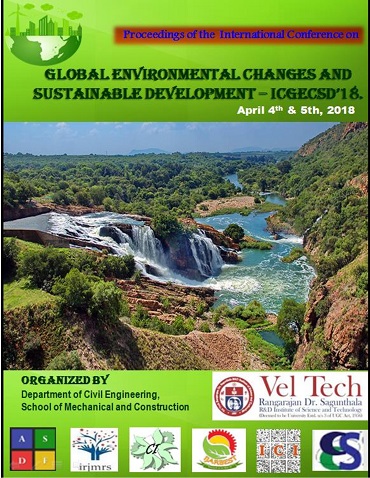- Publication Meta:Value
- Short Title:ICGECSD 2018
- Publisher:ASDF, India
- ISBN 13:978-81-933584-6-7
- ISBN 10:81-933584-6-5
- Language:English
- Type:Hard Bound - Printed Book
- Copyrights:ICGECSD Organizers / [email protected]
- Editor-in-Chief:Dr E B Perumal Pillai
- Conference Dates:04 - 05, April 2018
- Venue Country:Veltech R&D Institute of Science and Technology, Chennai, India
- Submitted Papers:230
- Acceptance Rate:8.12%
- Website:www.veltech.edu.in/icgecsd
Welcome to ASDF Electronic Digital Library!
ICGECSD 2018
ICGECSD 2018
International Conference on Global Environmental Changes and Sustainable Development 2018
Paper 018
Effect of Partial Replacement of Ceramic Waste and Steel Slag in Concrete
R M Saravana Kumar1, M Annapurani2, S Sivaranjani3
1,2,3Assistant Professor, Vel Tech Rangarajan Dr.Sagunthala R & D Institute of Science and Technology, Avadi, India
Abstract
Building industry is one of the fastest growing and a major energy consuming sector in India. Concrete has been the most significant building material for many generations and has not lost its market dominance over the years. The raw materials used for concrete are getting depletion now due to various reasons. The best possible solution to counter balance the depletion of natural sources of concrete would be the use of residual products of other industries in concrete. The added advantage with the use of residual products is the problem solving of disposal of those wastes. Thus protecting environment and avoiding dumping of the wastes is important in nowadays. This project presents the results of research of use of industrial by-products and waste material as coarse aggregate and fine aggregate in concrete. The objective is effectively use industrial by-products and waste materials in concrete without affecting the quality of concrete. Experimental investigations were carried out in M25 mix of concrete to study the effect of use of ceramic waste as partial replacement of fine aggregate and steel slag as partial replacement of coarse aggregate in concrete. Data on the physical and chemical properties of the constituents of concrete, compressive strength, split strength, flexural strength of controlled concrete and waste mixed concrete are presented. The mix ratio of 1:1.58:2.82:0.45 is used to cast cubes (150mm size), cylinder (φ150Χ300mm) prisms (100Χ100Χ500mm). Ceramic waste is replaced Fine aggregate in the percentage of 10%, 20%, 30%, 40%, 50% and steel slag is replaced Coarse aggregate in the percentage of 75% by the volume and test specimens were cast. The strength development for various percentage of replacement of aggregates is compared to the strength of normal concrete at various ages and it was found that 30% of ceramic waste concrete mix produces higher strength than the controlled mix.
Keywords
Author's Profile
Author profile can be generated and linked through our partners World Book of Researchers. To include your profile online Click Here. After it is approved, please email to edlib @ asdf.res.in to create a link with all the papers.
e-AID
ICGECSD.2018.018
Cite this Article as Follows
R M Saravana Kumar, M Annapurani, S Sivaranjani. Effect of Partial Replacement of Ceramic Waste and Steel Slag in Concrete. International Conference on Global Environmental Changes and Sustainable Development (2018): 18. Print.
© 2010 - by EDLIB .
All Rights Reserved.

